
Gritty’s evolution from googly-eyed hockey mascot to meme to leftist avatar, explained
On our burning hunger for moral clarity and the unexplainable heart of the universe.
By
Todd VanDerWerff@tvoti
Updated
Dec 31, 2018, 2:48pm EST
Share
Tweet
Share
Share
Gritty’s evolution from googly-eyed hockey mascot to meme to leftist avatar, explained
tweet
share
It wasn’t supposed to be like this.
The world was supposed to get better, right? Things were supposed to start making more sense. That’s what we were led to believe, at least. I don’t think I’m alone in feeling like something has broken in the world in the 21st century. How can it be that we’re living on a planet that is, in many ways, the best place to live in human history, but also on the verge of cataclysm?
The end is nigh, but what form it takes is open to suggestion. We might all die from the changing climate. We might all die from artificial intelligence taking our place. We might all die from the aliens who keep making cameo appearances in the hinterlands of our credible news sources.
So, yes, the free-floating fear of death is definitely a thing. But so is the sense that some fundamental promise of America has been lost in the name of progress weighted too heavily toward one side of our capitalist ledger. It feels, at least to me, like every day, the world becomes a little more ghoulish and harder to bear, and if I’m having a good day, well, all I have to do is hop on Twitter to be reminded of why I should maybe feel otherwise. (This says as much about the flaws of Twitter as anything else, I’m aware.)
I’m wondering, more and more, if what we want most in 2010s America — and what we are desperately lacking — is moral clarity. We want authoritative figures to say, “This is right, and this is wrong.” We long for superheroes to save us and demonstrate the power of good when it stands against evil. We want the morals of religious stories, but in a new secular language that preaches a desire to strive for the common good.
There is a hunger for this new meaning all around us. At least grant me that. The whole thing with Paddington 2 wouldn’t have happened otherwise.
Which brings me to Gritty.
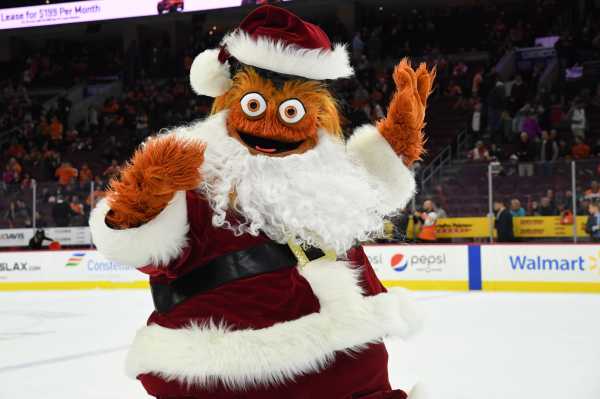
Gritty, Explained
An explainer in four acts
by Todd VanDerWerff
Act 1: Gritty the mascot
The easiest question to answer about Gritty is who he is and where he came from.
Gritty is the new mascot for the Philadelphia Flyers. He was introduced on September 24, 2018, as the hockey team’s very first mascot. He was designed by the freelance graphic designer Brian Allen; the impetus for creating Gritty, according to this Adweek article, was that the son of the Flyers’ COO asked why the team didn’t have a mascot in a city lousy with them. (Philadelphia’s three other major sports teams — the Eagles, the 76ers, and of course the Phillies — all have beloved mascots in Swoop, Franklin the Dog, and the Phillie Phanatic, respectively.)
Remarkably, Allen tells me, the Gritty we know is pretty much the Gritty he drew when he sat down to sketch a rough draft. The Flyers contacted Allen after seeing the “edgier” versions of the mascots he had designed for the 2017 Georgia-Auburn college football game as part of a Chick-fil-A ad campaign. All they told him, he says, was that they were hoping for a mascot you’d want to high-five but maybe not hug. (This is a failure. I would so hug Gritty.)
And because most of the typical mascot animals were already spoken for by other hockey teams — only the New York Rangers lack a mascot, now that the Flyers have one (though the Detroit Red Wings only have a somewhat confusing cartoon octopus) — “we eventually settled on a monster. Because with a monster, it doesn’t come with preconceived stereotypes,” Allen told me. “If you choose a bull, it’s gotta be aggressive, or if you choose a hawk, it’s gotta be cunning.”
A monster, though, can be whatever.
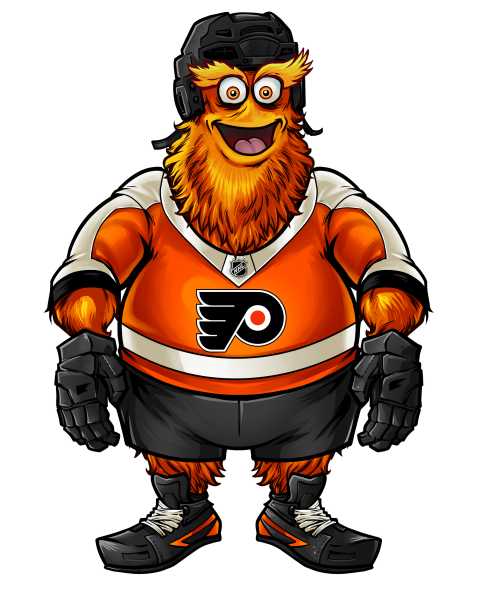
Gritty has frequently been likened to a Muppet, a comparison that Allen finds astute, as he drew a lot of inspiration from Jim Henson’s early Muppet creations and work for the 1982 film The Dark Crystal. “When he was on the ice, I wanted people even in the nosebleed section to see — is he angry? Is he happy?” Allen tells me. “The best way to do that is to make [his face] almost like a puppet face.”
Though Gritty did change slightly from Allen’s initial conception — as you can see in the early concept art above, he originally had bushy yellow eyebrows, which Allen says were discarded because they were too likely to detach from the costume while Gritty performed his antics — the version that was constructed as a costume by a company called Character Translations, Inc. and skated out onto the ice (and fell on his butt) on September 24 was extraordinarily close to the designer’s original vision.
Before Gritty’s debut, the Flyers sought input from David Raymond, who played the very first Phillie Phanatic and told the marketing team what to expect in terms of backlash, says Joe Heller, the Flyers’ vice president of communication and marketing. And everybody knew that the Flyers adopting any sort of mascot would be controversial with the team’s most hardcore fans, says Allen. But nobody could have predicted the phenomenon he would become.
“Pushback — we sort of expected some of that. Being completely candid, I think we expected it to be a lot longer than the turn [toward acceptance] was,” Heller says.
That Gritty’s origin story rests in the semi-wholesome story of someone’s kid wanting the Flyers to have a weirdo of their very own, and that his design is largely the work of one guy, is a big part of why Gritty feels like he wasn’t held back by the usual cultural gatekeepers. He seems, in some senses, like an accident, a hairball that corporate America coughed up and then didn’t bother to sand the rough edges off.
Gritty looks like the Phanatic’s beardier, more orange cousin. He seems a little like the result of a DNA splice between the Phanatic, a fully flowering maple tree, and Hagar the Horrible, the comic strip Viking. He has googly, wobbly eyes. Sometimes, his bellybutton is purple. Sometimes, it is orange. (“I think people maybe have overblown that he changes it. It’s just a thing he does sometimes,” says Heller, implying that Gritty himself can change his bellybutton color. Heller then tells me that if you look closely, the color of Gritty’s palms also changes sometimes.)
Sarah Schwab, the Flyers’ director of communications and marketing, points to Gritty’s googly eyes as something added during the construction of the character costume that wasn’t necessarily present in Allen’s sketch. She adds, nonchalantly, “He can blow smoke out of his ears. A lot of people don’t know that.”
Will wonders never cease?
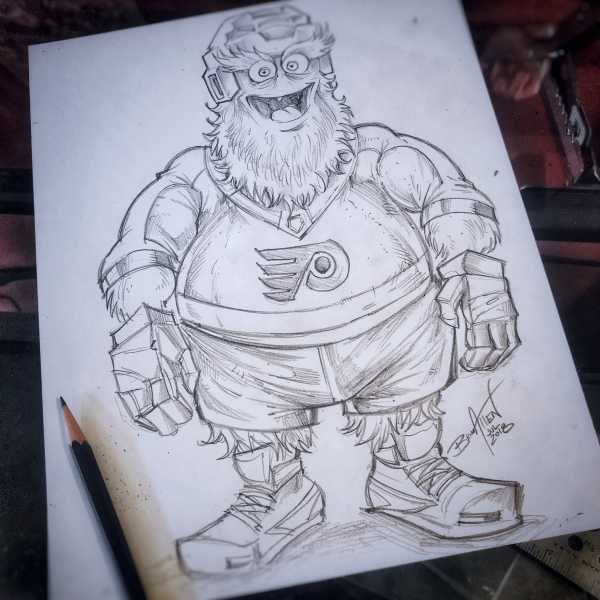
There are other sides to Gritty, less tangible ones. He looks like he could hold his own in a fight, for one. But he also looks like he’d be the kind of uncle who dresses up as Santa Claus at family Christmas celebrations — yet nonetheless knows when it’s time to be a stern disciplinarian. (He’s put a kid in the penalty box, for God’s sake.)
I keep referring to Gritty as a “he,” despite the fact that you’d think an orange beast wouldn’t necessarily have a gender. But Flyers personnel, Allen, and the Philadelphia Flyers’ website — the closest thing we have to Gritty canon — all use male pronouns to refer to him. The website also offers that he is something of a “bully,” a trait he apparently inherited from his father. We stan, as the kids say, a legend.
On some level, Gritty seems to embody the spirit of Philadelphia, a city known at once for brotherly love and for the beloved fictional boxer Rocky, the kind of working-class scrapper who has been embraced by a city full of working-class scrappers.
The Flyers, for their part, are really leaning into this whole … thing. Gritty has gone outside to play in the snow, and he’s appeared on national talk shows. He’s given pitch-perfect interviews about Thanksgiving to Time magazine, and he’s become one of the biggest stories in the NHL this season, despite the fact that the Flyers aren’t exactly having the best year. (They’re currently dead last in the Eastern Conference.) But Gritty will join the other NHL mascots at the league’s All-Star Game in February, presumably to pick on them, just another stop on his ascension to the big, googly-eyed throne. As corporate mascot introductions go, the rise of Gritty couldn’t have possibly gone better.
Except … Gritty has sort of transcended the Flyers to become something else entirely. And what he stands for is increasingly the opposite of a professional sports franchise. To figure out how we got there, we have to trace Gritty’s evolution from, “Oh, my God, what is that horrible thing?” to “Haha, Gritty is my boyfriend now!”
Thus, memes.
Act 2: Gritty as meme
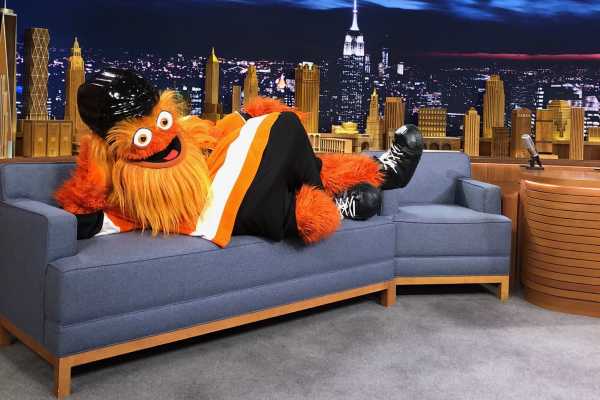
“I’m a freelance illustrator. I work with all kinds of companies and projects throughout the year, but this is the first time that I’ve ever designed something or drew something that actually became a personality,” Allen tells me. ”The success of Gritty comes from him sort of being a blank slate. His personality became what he needed to become.”
If Gritty’s design primed him for fame, then it was everything that followed his debut that transformed him into one of the biggest personalities of the year.
You likely knew Gritty was a sports mascot of some sort. You might even have known he was the Flyers’ mascot. But the odds are good that the first time you encountered the orange one (may he be ever benevolent) was as a rogue meme — a tweet or a JPEG or a GIF that wound its way out of the heart of the internet and before your eyes.
And when you first gazed upon it, you probably reacted the way a lot of us did when we first saw Gritty back in September: “What the fuck is that thing?”
Yeah, it’s easy to forget now, but the initial response to Gritty was one of weird terror. Somehow, the Philadelphia Flyers had conjured a sinister children’s television character straight out of a creepypasta, turned it into their mascot, and then set it loose on the internet. Gritty’s shtick isn’t that he’s lovable and huggable. It’s that he’s super confrontational and just a little scary.
“Gritty became an anti-mascot pretty quickly. He embraced the negative attitude,” says Allen.
I mean. Lest we forget.
So. Gritty is chaotic good. That’s not the type of characteristic you might have thought to ascribe to a great new mascot in 2018, regardless of whether he represents a city famous for a-bitin’ and a-scrappin’. But something happened when Gritty was introduced that endeared him to Philadelphians everywhere: He took on Pittsburgh.
Well, to be fair, the Pittsburgh Penguins started it, responding to Gritty’s debut with a hearty, “lol ok.” Gritty’s response came just nine minutes later and cut to the heart of what has made the mascot such a phenomenon: He wasn’t gonna take shit from anybody.
It’s important to note that at this point, Gritty was still in the “strictly controlled by corporate brand accounts” phase of his existence. It would have been entirely understandable if Gritty had simply become a curio after the early backlash, a thing we all talked about for a day and then moved on from. (Allen briefly worried that Flyers’ fans initial backlash to Gritty would cause the team to apologize and back away from the guy.)
But Philadelphia is a city that loves its big, goofy mascots, and it’s a city that enjoys maintaining a friendly rivalry with its cross-state cousin Pittsburgh. It’s also a city that perpetually (and unfairly, some would say) lives in the shadow of New York and Washington, DC. In some intangible sense, Philly is Gritty. Thus, a tweet full of bluster that allowed people to practically taste the chip growing on Gritty’s shoulder could only help pull Gritty into Philly’s good graces.
And after Philadelphia embraced Gritty, goes the story, so would the world. The real turning point, for me, came when Gritty’s skyrocketing meme status crossed over with the then-bountiful meme capacity of A Star Is Born shortly after his debut, mostly via tweets and images that replaced Lady Gaga in the film with a giant orange hockey monster. And just as in the plot of A Star Is Born, Gritty rose into the stratosphere while the movie slowly eased its way out of meme central (though I’ll always love a good “just wanted to take another look at you” meme).
But almost from the moment of his introduction, memesters began making the voyage from “what a weird looking mascot” to “but I love him” in no time at all. Soon, Gritty had all the hallmarks of a powerful meme icon in 2018, and few of them were overseen by the Flyers. He had a subreddit. He had Instagram accounts both official and unofficial. He had several Facebook groups, including one called “Gritty Memes for Philly Teens.”
People got Gritty tattoos and Christmas sweaters and desserts. He became the subject of cultural commentary on sites ranging from the Ringer to the New Yorker (which listed him as one of the “good men” of 2018). A faux-Gritty appeared on Conan O’Brien and was unmasked as … well, just watch it.
Gritty was everywhere. He didn’t record a Christmas album or anything, but had he done so, I think most of us would have just shrugged and said, “Okay. Sure.” There’s more to come — Heller and Schwab say they have a “Gritty bucket list” — but weirdly, I’m into it.
That’s because somehow — it’s probably the googly eyes — he hasn’t worn out his welcome. He’s only continued to gain strength.
A moment, here, to note that the Gritty Twitter account has been ridiculously well-run, right from the start. It always retweets the best Gritty memes and clips of his on-ice antics. But it doesn’t over-tweet, sometimes letting whole weeks go by without posting new content. Indeed, the account posted just 161 tweets between September 24 and December 23. By not seeming desperate to make Gritty cool, the Twitter account has done a great job of making Gritty seem … cool.
A very small team of people run the account, according to Schwab — just three or four in total, and one of them is the mysterious man who wears the Gritty costume. (I had no luck trying to figure out his identity. State secrets!) A lot of Gritty’s tweets are improvised on the fly. “What you’re seeing on Gritty’s account isn’t vetted up 15 flights of stairs. It’s what makes the most sense for Gritty in that moment,” Schwab says.
But the fact that everything Gritty does feels slightly off balance and unhinged, rather than subject to intense corporate control, meant something unusual happened. This corporate mascot suddenly became a key figure in memes for the left shortly after his introduction.
Not only did Gritty go political, but it only made him more popular.
Act 3: Gritty as political statement
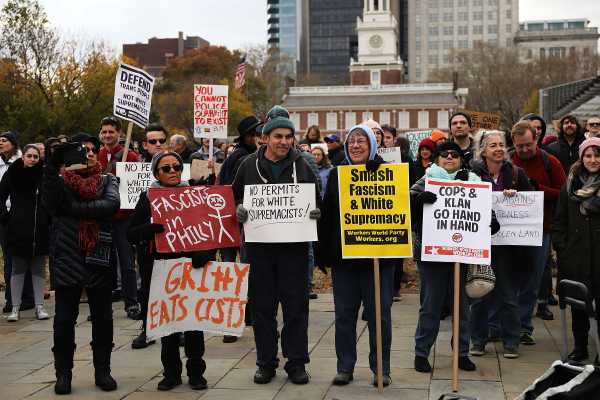
If you were looking for a succinct explanation of the Gritty phenomenon, first of all, I’m so, so sorry. But second of all, you could do worse than reading the resolution that the Philadelphia City Council adopted to officially welcome the beast to the city. It tells the story of Gritty’s introduction, backlash, and unstoppable rise to fame in a much more condensed fashion than this article does.
And then, buried deep within it, is this paragraph:
It goes on from there to talk about a guy who tattooed Gritty on his leg. But the point is that if you’re at all active on left-leaning Twitter, you’ve likely seen Gritty pop up in leftist memes or at anti-Trump protests. As Philadelphia City Council member Helen Gym said to the Ringer:
Insurrectionary!
This idea comes up a lot when you ask people why they like Gritty. He just exemplifies, in some abstract way, the utter strangeness of life in 2018, of rolling downhill toward a cliff and stomping on the brakes in hopes they’ll start working again. It’s not hard to imagine Gritty clinging to the back of the car for dear life, howling in fear and/or excitement. (If Gritty howls, that is.) He’s almost millennials’ love of absurdist humor (theorized by the Washington Post’s Elizabeth Bruenig to be driven by having grown up in what feels like an absurdist hellscape) realized in one monstrous physical form.
When I ask the folks with the Flyers about this aspect of Gritty’s persona, they offer me one of the franchise’s few party lines on Gritty that feels a little corporatized: “Politically, Gritty doesn’t know his right from his left,” Schwab says, though she allows, a few moments later, that nobody is trying to discourage this sort of memeing. “In terms of seeing him take on a life of his own in memes, our team loves to see it. … We like the idea that people have embraced it this much.”
Which means the central conflict remains between the idea of Gritty as a corporate mascot who is, at least on some level, an advertising construct, and Gritty as a leftist revolutionary who can stand in for any number of progressive and leftist movements, from campaigns for trans rights to attempts to decrease racial inequity to antifa battles against the alt-right.
The best explanation for why this has happened beyond the simple idea that it just happened came from Malcolm Harris, a self-identified communist and an early member of the Occupy Wall Street movement, as well as the author of the book Kids These Days: Human Capital and the Making of Millennials, in a tweet I embedded above: Gritty looks like he’s “tryna fight.”
I reached out to Harris and asked him to expand on this idea, and here’s what he said: “The bourgeois humanism of social democracy has flooded the engine of American revolt, but in the mascot’s rabid eyes we recognize anew the unavoidable truth: The people have enemies and they must be destroyed.”
That Gritty can simultaneously be a high-fivable hockey mascot whom kids adore and an advocate for the radical dismantling of capitalism might still feel like a reach to many. But I think Harris is right that Gritty just looks like he’s about to tear everything down. In the same way that Pepe the Frog somehow became a symbol of the alt-right (to his creator’s irritation) because he looked like the kind of bored online troll who would check out of society and laugh at the prospect of sowing chaos, Gritty looks like somebody who’s realized that the world can’t be saved without an earnest attempt to grapple with everything in it that’s broken.
Perhaps the best way to explain this idea is via the too-infrequently-used Ascending Muppet meme, which nods to how Gritty does kinda look like a Jim Henson creation. In it, a series of Muppets grow progressively more radical in design right alongside progressively radicalized politics, until Gritty arrives at the end to advocate for, say, fossil fuel companies being forced to use hamster wheels as a power source.
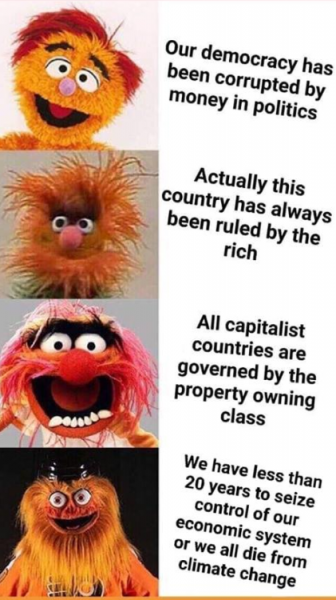
What all these memes share is the way they get at Gritty’s correctness as a figure of leftist adoration. Indeed, when the alt-right briefly tried to co-opt Gritty by putting him in a Nazi uniform, the effort failed spectacularly. It is a common trope among alt-right folks that the left can’t meme — and yet there’s Gritty, standing as a one-monster proof to the contrary.
If you fear the end of the world, if you feel dehumanized and unsupported by capitalism, if you’ve grown weary of a system that can seem as if it only sees you in terms of the value you might create for it and not as a human being with intrinsic value — and even if only a couple of these things are true some of the time — it’s hard not to live in the world and not want someone to stand up and start shouting about it, instead of offering bland platitudes about how everything is going to be all right, even if everything is going to be all right. Everything doesn’t feel all right to too many of us (this author included), and it sometimes seems as if those in power not only don’t understand but don’t particularly care.
Gritty, for whatever reason, speaks to the desire to have a loud voice fighting on the side of those who demand a larger piece of the pie. He can’t, so far as anybody knows, even talk. His corporate bosses insist he is apolitical. But just look at him. You know he would shout if he could.
Does that explain it? Do you feel like you get Gritty now? Do you understand?
No? Well …
Act 4: Gritty as the unexplainable heart of the universe
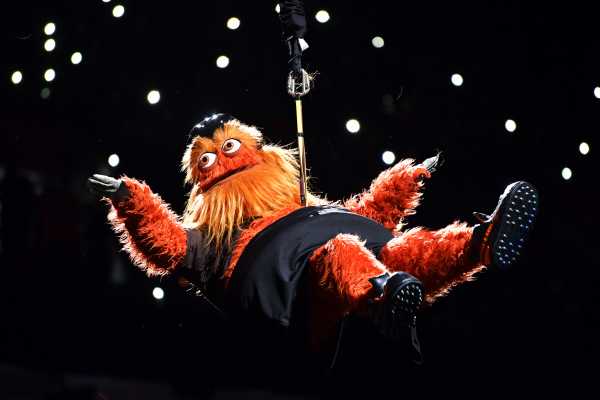
In his landmark critical text on fairy tales and their efficacy in working with children titled The Uses of Enchantment, author Bruno Bettelheim writes of these ancient stories, “The child intuitively comprehends that although these stories are unreal, they are not untrue.” (Bettelheim was accused of plagiarizing large swaths of The Uses of Enchantment from Julius Heuscher’s A Psychiatric Study of Myths and Fairy Tales, though not, so far as I can tell, this particular passage.)
For instance: The events of Cinderella did not literally happen. No maid was ever transformed into a princess by a fairy godmother and a pair of glass shoes that fit just so. Yet we keep retelling the story, twisting and reconfiguring it for each new era, because something within it speaks so deeply to some buried psychological need.
And that need changes with time! The Cinderella story in a society like ours might be made to emphasize, say, the ways that Cinderella is extraordinary even as nobody notices her, the better to prop up a myth of a meritocracy, something we believe in because we badly want it to be true. But in medieval societies, it might have been about gender roles within marriage. In the early industrial age, it might have been about a desire to return to some lost, supposedly superior society. And so on.
The point is that this is the section where I’m supposed to finally explain Gritty once and for all, yet Gritty will always remain, on some level, inexplicable.
I can tell you where he came from and how he was designed. I can tell you the story of how he evolved from nightmare fuel to beloved meme. I can even try to explain why his memeified self speaks to the left and not the right. But we can never fully escape the idea that me explaining why Gritty appeals to you can only ever really explain why he appeals to me.
This is the magic trick of cultural criticism, of course. I tell you why I like or hate a thing, and I try to provide the best argument that supports my case. Then you decide whether you agree. But I cannot tell you whether a thing is good or bad, what politics it supports, or what its ultimate message is, because there isn’t an answer to that question.
Instead, there’s a void where the two of us can meet and maybe — maybe — find common ground. We can sit and watch the same movie and still see completely different films, as you’ll well know if you’ve ever walked out of a theater arguing with someone about what you just saw. During our conversation, we might build something new ourselves: Here’s an empty space, a blank slate, a demilitarized zone where we can talk about anything, so long as it relates to this one thing.
And look, I get it: Vox is a website that explains things. It is my job to tell you what Gritty “means.” But we attach meaning to things irrespective of their actual content all the time, and that meaning shifts and changes with where we are as a culture. Gritty is unreal. The monster can change the color of his bellybutton, can blow smoke from his ears. His unseeing eyes wobble and spin independently of one another, and many, many different parts of him squeak (I’m assured; I haven’t gotten to test this myself). Of course he’s unreal. But he is not untrue.
You can never quite predict when or how, but sometimes, these empty spaces open up in our collective subconscious, and something shows up to occupy them. Suddenly, a thing is there, and it fits the shape of a void you hadn’t previously noticed. You might characterize Gritty as gross or bizarre or horrible to behold. You might think he is fun meme material. You might admire him as a triumph of personal design smuggled into a corporate context. You might believe he is an advocate of the proletariat. He might be all of these things or none of these things.
But there is a chaos to Gritty that speaks to something in our culture right now. That chaos will be different for me than it is for you. But we are both feeling it, yes? Things weren’t supposed to be this way. But also, things don’t have to be this way.
So let me start. 2018 has been a hard year for me. I have been through a lot, even as I have accomplished a lot. I have felt battered and broken and bruised, and I have turned my whole self inside out in the pursuit of some more fundamental truth about who I am and what I want from my life. And into the middle of that came this weird orange monster, and he made me laugh so much, sometimes for very stupid reasons. I don’t quite get it, but I’m trying.
So. Now. How about you?
Appendix 1: Gritty love from all around the world
While writing this story, I asked my Twitter followers to explain to me why they love Gritty. They more than obliged. You should read all the responses to this thread, but I’ve embedded a few of my favorites below.
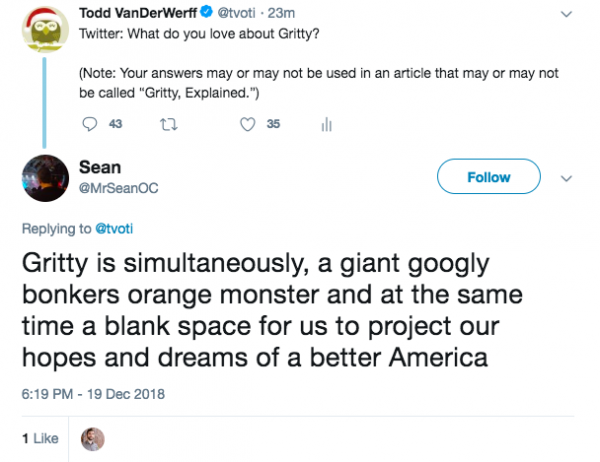
Appendix 2: Consider singing these “Gritty Carols” at your holiday festivities!
“Gritty Is My Supervisor Now”
(to the tune of “Winter Wonderland”)
Sleigh bells ring
Are you listenin’
In the lane
Snow is glistenin’
A beautiful beast
All orange and hairy
Gritty is my supervisor now.
Got a beard
He’s from Philly
From half-court
He’ll shoot big threes
He’ll frolic and skate
The hockey team way
Gritty is my supervisor now!
[Repeat 4x]
“It’s the Most Grittiest Time of the Year”
(to the tune of “It’s the Most Wonderful Time of the Year”)
It’s the most Grittiest time of the year!
When the orange man comes calling
On ice he’ll keep falling
Trip over his beard!
It’s the most Grittiest time of the year!
It’s the Grit-Grittiest season of all!
Let’s go play some hockey!
How do you play hockey?
Does it feature a ball?
It’s the Grit-Grittiest season of all!
[never repeat]
“Gritty Claus Is Comin’ to Town”
(to the tune of “Santa Claus Is Comin’ to Town”)
You better watch out!
You better watch out!
You better watch out!
You better watch out!
Gritty Claus is comin’ to town!
He’s makin’ a list!
You better watch out!
He’s comin’ for you!
You better watch out!
Gritty Claus is comin’ … TO TOWN!!!
[Repeat endlessly]
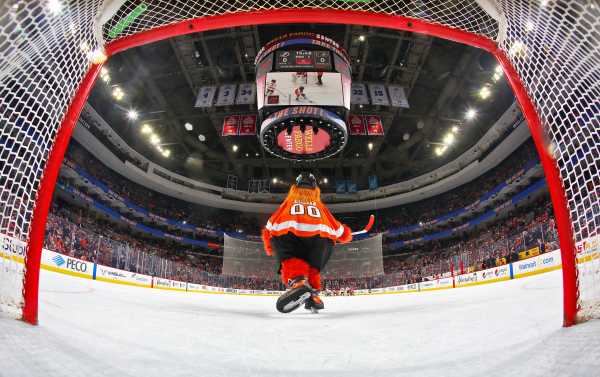
Sourse: breakingnews.ie
0.00 (0%) 0 votes


































